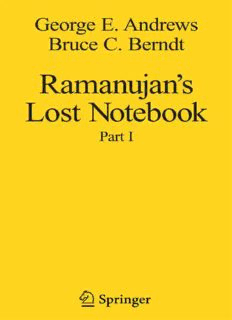
Ramanujan's Lost Notebook: Part I PDF
Preview Ramanujan's Lost Notebook: Part I
Ramanujan’s Lost Notebook Part I George E. Andrews Bruce C. Berndt Ramanujan’s Lost Notebook Part I GeorgeE.Andrews BruceBerndt DepartmentofMathematics DepartmentofMathematics EberlyCollegeofScience UniversityofIllinois,Urbana-Champaign PennsylvaniaStateUniversity Urbana,IL61801 StateCollege,PA16802 USA USA [email protected] [email protected] MathematicsSubjectClassification:14H42,33D15,33C75,40A15 LibraryofCongressControlNumber:2005923547 ISBN-10:0-387-25529-X Printedonacid-freepaper. ISBN-13:978-0387-25529-3 ©2005SpringerScience+BusinessMedia,Inc. All rights reserved. This work may not be translated or copied in whole or in part without the writtenpermission ofthepublisher (SpringerScience+BusinessMedia, Inc.,233Spring St.,New York,NY10013,USA),exceptforbriefexcerptsinconnectionwithreviewsorscholarlyanalysis. Useinconnectionwithanyformofinformationstorageandretrieval,electronicadaptation,com- putersoftware,orbysimilarordissimilarmethodologynowknownorhereafterdevelopedisfor- bidden. The use in this publication of trade names, trademarks, service marks, and similar terms, even if theyarenotidentifiedassuch,isnottobetakenasanexpressionofopinionastowhetherornot theyaresubjecttoproprietaryrights. PrintedintheUnitedStatesofAmerica. (MVY) 9 8 7 6 5 4 3 2 1 springeronline.com Readers will learn in the introduction to this volume that mathemati- cians owe a huge debt to R.A. Rankin and J.M. Whittaker for their efforts in preserving Ramanujan’s “Lost Notebook.” If it were not for them, Ra- manujan’slostnotebooklikelywouldhavebeenpermanentlylost.Rankinwas borninGarlieston,Scotland,inOctober1915anddiedinGlasgowinJanuary 2001. For several years he was professor of Mathematics at the University of Glasgow. An account of his life and work has been given by B.C. Berndt, W. Kohnen, and K. Ono in [79]. Whittaker was born in March 1905 in Cam- bridge and died in Sheffield in January 1984. At his retirement, he was vice- chancellor of Sheffield University. A description of Whittaker’s life and work has been written by W.K. Hayman [150]. Through long lapse of time, This knowledge was lost. But now, as you are devoted to truth, I will reveal the supreme secret. Bhagavad Gita, IV.2 & IV.3 Preface This volume is the first of approximately four volumes devoted to the exami- nation of all claims made by Srinivasa Ramanujan in The Lost Notebook and OtherUnpublishedPapers.ThispublicationcontainsRamanujan’sfamouslost notebook; copies of unpublished manuscripts in the Oxford library, in partic- ular, his famous unpublished manuscript on the partition function and the tau-function; fragments of both published and unpublished papers; miscella- neous sheets; and Ramanujan’s letters to G.H. Hardy, written from nursing homes during Ramanujan’s final two years in England. This volume contains accounts of 442 entries (counting multiplicities) made by Ramanujan in the aforementioned publication. The present authors have organized these claims into eighteen chapters, containing anywhere from two entries in Chapter 13 to sixty-one entries in Chapter 17. Contents Preface ........................................................ ix Introduction................................................... 1 1 The Rogers–Ramanujan Continued Fraction and Its Modular Properties................................ 9 1.1 Introduction ........................................... 9 1.2 Two-Variable Generalizations of (1.1.10) and (1.1.11) ....... 13 1.3 Hybrids of (1.1.10) and (1.1.11) .......................... 18 1.4 Factorizations of (1.1.10) and (1.1.11)..................... 21 1.5 Modular Equations ..................................... 24 1.6 Theta-Function Identities of Degree 5 ..................... 26 1.7 Refinements of the Previous Identities..................... 28 1.8 Identities Involving the Parameter k =R(q)R2(q2).......... 33 1.9 Other Representations of Theta Functions Involving R(q) ... 39 1.10 Explicit Formulas Arising from (1.1.11) ................... 44 2 Explicit Evaluations of the Rogers–Ramanujan Continued Fraction ................................................... 57 2.1 Introduction ........................................... 57 2.2 Explicit Evaluations Using Eta-Function Identities.......... 59 √ √ 2.3 General Formulas for Evaluating R(e−2π n) and S(e−π n) .. 66 2.4 Page 210 of Ramanujan’s Lost Notebook .................. 71 2.5 Some Theta-Function Identities .......................... 75 2.6 Ramanujan’s General Explicit Formulas for the Rogers–Ramanujan Continued Fraction ................... 79 3 A Fragment on the Rogers–Ramanujan and Cubic Continued Fractions ....................................... 85 3.1 Introduction ........................................... 85 xii Contents 3.2 The Rogers–Ramanujan Continued Fraction ............... 86 3.3 The Theory of Ramanujan’s Cubic Continued Fraction...... 94 3.4 Explicit Evaluations of G(q) .............................100 4 Rogers–Ramanujan Continued Fraction – Partitions, Lambert Series ............................................107 4.1 Introduction ...........................................107 4.2 Connections with Partitions .............................108 4.3 Further Identities Involving the Power Series Coefficients of C(q) and 1/C(q) .......................................114 4.4 Generalized Lambert Series..............................116 4.5 Further q-Series Representations for C(q)..................121 5 Finite Rogers–Ramanujan Continued Fractions ............125 5.1 Introduction ...........................................125 5.2 Finite Rogers–Ramanujan Continued Fractions.............126 5.3 A generalization of Entry 5.2.1...........................133 5.4 Class Invariants ........................................137 5.5 A Finite Generalized Rogers–Ramanujan Continued Fraction 140 6 Other q-continued Fractions ...............................143 6.1 Introduction ...........................................143 6.2 The Main Theorem.....................................144 6.3 A Second General Continued Fraction.....................158 6.4 A Third General Continued Fraction......................159 6.5 A Transformation Formula ..............................162 6.6 Zeros .................................................165 6.7 Two Entries on Page 200 of Ramanujan’s Lost Notebook ....169 6.8 An Elementary Continued Fraction .......................172 7 Asymptotic Formulas for Continued Fractions .............179 7.1 Introduction ...........................................179 7.2 The Main Theorem.....................................181 7.3 Two Asymptotic Formulas Found on Page 45 of Ramanujan’s Lost Notebook .............................187 7.4 An Asymptotic Formula for R(a,q) .......................193 8 Ramanujan’s Continued Fraction for (q2;q3)∞/(q;q3)∞....197 8.1 Introduction ...........................................197 8.2 A Proof of Ramanujan’s Formula (8.1.2) ..................199 8.3 The Special Case a=ω of (8.1.2).........................210 8.4 Two Continued Fractions Related to (q2;q3)∞/(q;q3)∞ .....213 8.5 An Asymptotic Expansion...............................214 Contents xiii 9 The Rogers–Fine Identity..................................223 9.1 Introduction ...........................................223 9.2 Series Tran(cid:1)sformations ..................................223 99..43 TThhee SSeerriieess (cid:1)∞n∞=0(q−n(13)nn+q1n)(/n2+(11)−/2q.2.n.+.1.).........................................223227 (cid:1)n=0 9.5 The Series ∞ q3n2+2n(1−q2n+1) ......................237 n=0 10 An Empirical Study of the Rogers–Ramanujan Identities ..241 10.1 Introduction ...........................................241 10.2 The First Argument ....................................241 10.3 The Second Argument ..................................247 10.4 The Third Argument ...................................247 10.5 The Fourth Argument ..................................248 11 Rogers–Ramanujan–Slater–Type Identities ................251 11.1 Introduction ...........................................251 11.2 Identities Associated with Modulus 5 .....................252 11.3 Identities Associated with the Moduli 3, 6, and 12..........253 11.4 Identities Associated with the Modulus 7..................256 11.5 False Theta Functions ..................................256 12 Partial Fractions...........................................261 12.1 Introduction ...........................................261 12.2 The Basic Partial Fractions..............................262 12.3 Applications of the Partial Fraction Decompositions ........265 12.4 Partial Fractions Plus...................................272 12.5 Related Identities ......................................279 12.6 Remarks on the Partial Fraction Method ..................284 13 Hadamard Products for Two q-Series......................285 13.1 Introduction ...........................................285 13.2 Stieltjes–Wigert Polynomials.............................286 13.3 The Hadamard Factorization ............................288 13.4 Some Theta Series......................................289 13.5 A Formal Power Series ..................................291 13.6 The Zeros of K∞(zx) ...................................295 13.7 Small Zeros of K∞(z)...................................297 13.8 A New Polynomial Sequence.............................297 13.9 The Zeros of pn(a) .....................................302 13.10 A Theta Function Expansion ............................304 13.11 Ramanujan’s Product for p∞(a)..........................305
Description: